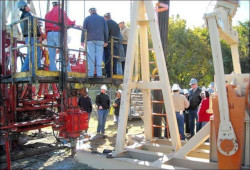Education and Training
Introduction
Effective oil and gas safety education and training is a process that gives employees everything they need to know and do to achieve excellent performance. It starts with new employee selection and ends with the verification of knowledge, skills, and abilities (KSAs). Effective safety education and training:
- reinforces the belief that safety is a core value (not a priority) - an essential part of every job;
- identifies safety, requirements, standards, and results;
- helps ensure employees have excellent KSAs to work safely; and
- results in more efficient and productive operations, and long-term company success.
The Importance of Safety Education and Training
The benefits listed above emphasize the importance of conducting world-class safety education and training that ensures workers are properly selected and oriented, completely trained, evaluated, retrained when necessary, and always motivated be the best.
Elements of Effective Safety Education and Training
Selection: It's important to properly select from a qualified pool of applicants. A well-planned application process will help select qualified employee and that will also improve employee retention.
Orientation: A safety orientation will educate new employees on the safety and health aspects of their jobs, and will help take the surprise out of first days on the job.
Training: Initial and continuing safety training, especially with new employees, must compensate for their lack of knowledge, skills, and abilities in the demanding work they must perform. Accidents can happen quickly at a worksite if roughnecks and others do not understand and have the proper attitudes about the procedures they must follow, and why they are necessary.
Retraining: Remaining aware of danger, as familiarity kills caution, requires constant retraining in a variety of ways in order to retain interest. Retraining should be conducted if it appears workers do not have adequate knowledge or skills to perform safely, or as needed to ensure that employees are able to perform their tasks in a safe manner.
Motivation: Worker motivation to work safely and to stay with the industry must come from the companies. The opportunity to be employed year around, developing pride in working for a good company, experiencing satisfaction with job conditions, knowing that the work is meaningful and being rewarded generously should lessen the movement of workers through the industry.
Evaluation: Total safety education and training is successful only after the employer can verify that employees are performing at or above the employer's standards. To achieve that, employees should be evaluated by competent persons.
Knowledge Check Choose the best answer for the question.
6-1. Why is safety education and training so important, especially for new employees?
You forgot to answer the question!

